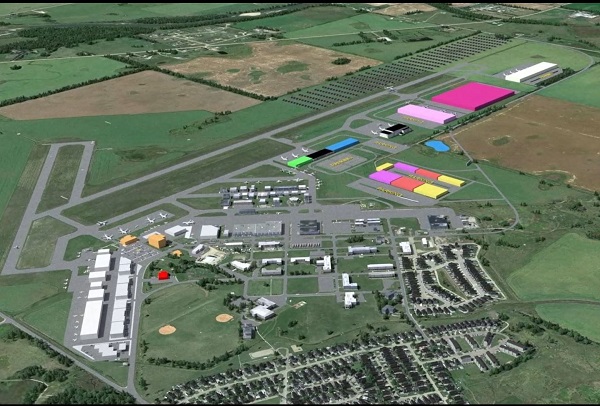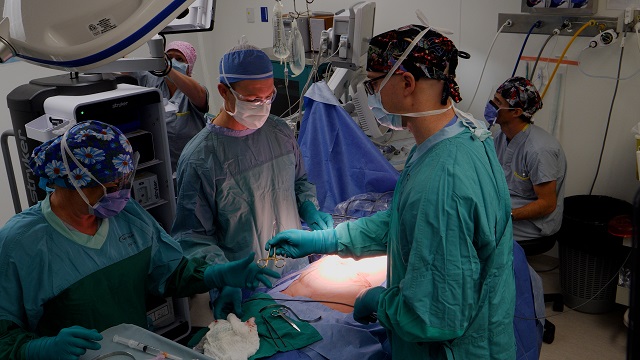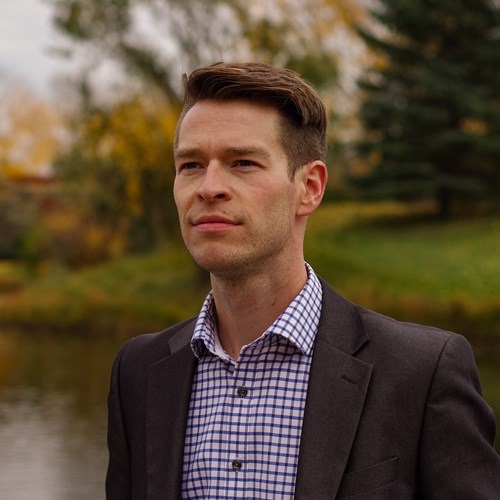Central Alberta
New RDC President out to make Red Deer “the first choice for post-secondary education in this region”

A message from Dr. Peter Nunoda, Red Deer College President
Connections and collaboration essential for RDC’s new President
I believe that Red Deer College is a pillar in this community. That’s one of the many things that initially attracted me to this institution.
When I was first learning about RDC and the central Alberta region, I realized there was a special opportunity here to work closely with community members. Coming from Vancouver Community College, where I served as President, we had made positive connections with our community. But at RDC, I saw there was an opportunity to become more closely connected to the larger central Alberta region. By working together and listening to what the community at large wants from this college, we can make an incredible difference.
Another pivotal reason that I came to Red Deer College was the opportunity to be part of the university transition. I have a wide familiarity with post-secondary institutions from my past experiences at the university, university-college and college settings. I have worked and led organizations and teams at all of these levels, and I’m excited about the path that RDC is on. Our future model is unique in that we’re not talking about a traditional university. By keeping the range of credentials that we currently offer and adding degrees, we will be maximizing the opportunities for our students.
I believe in the value of a college education, first and foremost, as a way to prepare students for the work force, and we never want to lose this. In my family, all three of my children are currently in post-secondary, and my middle daughter is a great example of the importance of a college education. She started in a Bachelor of Science program, but was concerned about her job prospects. She then transferred to a Laboratory Sciences Technologist Diploma and has had great success in this program, including an amazing co-op experience.
This example demonstrates the need to have a wide range of opportunities for students, including applied and hands-on knowledge in all of our programs. As we develop our own degrees, we will always keep the ideas of work integrated and experiential learning, as well as practicums and co- ops in mind. This will help our students across all of our programs to transition seamlessly to the workplace. We’re at an important time, when even more students from the region will be able to stay in Red Deer and complete their education in Red Deer, graduating with degrees. We want to prepare our students and graduates for the wider world, but we also want them to have opportunities to learn and to work right here in central Alberta.
We’re evolving as an institution, and we’re doing this at a time when there is an increasing need for post-secondaries to establish their own revenue streams to be continuously financially stable. This will require innovative thinking as we move forward, and that’s an area that I’m passionate about. For me, innovation has many components, and an important one is considering how we can repackage the education that we offer. What do our programs and credentials look like moving forward? Are we maximizing blended and distance options, and offering pieces of traditional education in ways that make sense for our students? Another area we will be looking at is our international student population and how to establish a balanced approach to increase international registrations. All of these questions require a lot of out-of-the-box thinking, but they are important topics to consider as we look to the university of our future.
When we consider the future, it’s my vision to ensure we never lose sight of where we’ve come from. While honouring our history, we want to create a legacy of Red Deer University being an institution that’s virtually self-sustaining. We also want people to look at Red Deer as the first choice for post-secondary education in the region, and we will work with our community members to benefit RDC and all of central Alberta.
This past June, I came to RDC for my announcement as the new President, and I was amazed at the number of people who were in attendance. This really reinforced to me how many people will be counting on me. I know – and am very appreciative – of the fact that I will be part of a team at Red Deer College, but I still take my responsibility as President very seriously. There is important work to be done here over the next few years, and I look forward to undertaking it together.
Dr. Peter Nunoda is Red Deer College’s President.
Alberta
Province boosts development strategies at Regional Airports

Proposed area for development at Red Deer Regional Airport highlighted by bright colours
Building Alberta’s regional airport network
Alberta’s government is investing $1.13 million to support the development of regional airports across the province.
Alberta’s regional airports connect people, create jobs and help local businesses reach new markets. This investment will facilitate the growth of the province’s regional airport network, enabling the seamless movement of people and goods, and creating more opportunities for municipalities and local industry to thrive.
“Alberta’s aviation industry plays an important role in strengthening and diversifying our economy by expanding access to markets and creating jobs in the province. Regional airports are key assets in supporting the air sector and the movement of people. This investment will support the growth of Alberta’s regional airports and help restore and develop connections between our regional and international airports.”
The grant funding will support 10 regional airports in developing business cases and feasibility studies for improved airport infrastructure and air transportation. The projects will allow the airports to identify, explore and prioritize improvements and opportunities to increase their economic competitiveness, such as increasing the number of air carriers or the efficiency of aircraft movement to bolster the economic output of regional airports.
“Regional airports play a critical role in keeping Alberta connected and our economy growing. We are working with our partners to ensure all corners of the province are in the best position to attract job-creating investment and opportunities from around the world for all Albertans.”
The grants include $120,000 to the Red Deer Regional Airport for a land development strategy, which will inform the airport about how it can leverage infrastructure and facility improvements, such as terminal expansion and airside land development, that will better position the airport as a hub for economic activity.
“The continued support from the province positions the Red Deer Regional Airport as a compelling and competitive location to do business. Now more than ever, we are primed to attract new investment opportunities, create jobs and strengthen central Alberta’s economic landscape.”
The funded projects vary in scope and size depending on the specific needs of each airport. They include exploring airport certification to support scheduled air services, airport commercial development, commercial air services, hangar development and development of strategic business cases to restore regional airports’ positions as primary transportation hubs.
“CAEP is proud to showcase the importance of the Red Deer Regional Airport as a true ’hub‘ in the Central Alberta Region. Transportation is critical to a thriving region that leads to sophisticated manufacturing, technological innovation and investment attraction to enhance and support our economic corridors. Continued growth at the RDRA is proof that the region is thriving and a ’destination of choice‘ for investment.”
The projects will also support the creation of an air service business case to attract new airlines, analyzing highest-need routes, determining baseline capacities of airport infrastructure, and identifying capital asset rehabilitation and replacement requirements.
“Regional airports support economic development and serve as a hub for emergency services for rural Alberta. The funding provided today will benefit many rural communities and represents a strong step in maintaining Alberta’s rural transportation network.”
This investment demonstrates Alberta’s commitment to growing the aviation sector and diversifying the economy. Alberta’s government will continue working closely with regional airports to ensure they are drivers of economic growth in the province.
Quick facts
A total of $1,129,424 is being provided to support 10 regional airports:
- Cold Lake Regional Airport
- Feasibility Study for Airport Certification to Support Scheduled Air Services – $144,000
- Whitecourt Airport
- Commercial Development Feasibility Study – $78,684
- Lloydminster Municipal Airport
- Commercial Air Services Feasibility Study – $113,988
- Peace River Regional Airport
- Peace River Airport Master Plan – $57,552
- Lethbridge Airport
- Hangar Development Feasibility Study and Business Case – $150,000
- High Level Airport
- High Level Airport Master Plan – $56,000
- Red Deer Regional Airport
- Land Development Strategy and Implementation Plan – $120,000
- Medicine Hat Regional Airport
- Feasibility and Business Case for Airport Growth and Development – $150,000
- Grande Prairie Airport
- Canadian Border Services Agency Facilities Study – $140,000
- Fort McMurray International Airport
- Business Case to Recapture Lost Passenger Traffic – $119,200
Alberta
Doubling surgical capacity in Rocky Mountain House

Rural Albertans will be able to access surgeries quicker and closer to home now that the expansion and renovation of the Rocky Mountain House Health Centre is complete.
The Rocky Mountain House Health Centre has been providing residents with health care since 1971, including surgical services. Alberta Infrastructure has completed an addition to the facility, which includes a new operating room. This will enable approximately 120 Albertans per month to receive surgery, doubling the number of monthly surgeries. This additional, brand-new operating room is also expected to decrease the wait lists for surgeries.
The expanded Rocky Mountain House Health Centre provides an additional 440 square metres (4,736 square feet) and includes:
- a new operating room,
- 6 additional recovery beds,
- a patient support area, and
- an updated medical device reprocessing department.
The new spaces can be accessed from the existing site thanks to the addition of an upgraded hallway that connects the two buildings.
“Completing the expansion and renovation of the Rocky Mountain House Health Centre is a significant step forward in delivering Alberta Surgical Initiative projects province wide. This investment into health care infrastructure will increase surgical capacity, helping Albertans get treatment when and where they need it.”
The Rocky Mountain House Health Centre upgrade is part of the Alberta Surgical Initiative (ASI), which aims to enhance surgical capacity across the province by expanding and maximizing existing health care space. Over the next three years, the 2024 Capital Plan is providing $313 million for ASI projects throughout the province.
Alberta Infrastructure and Alberta Health Services share the responsibility for delivering ASI projects. Alberta Health Services leads the delivery of smaller projects, while Alberta Infrastructure delivers capital projects over $5 million.
“Albertans deserve timely access to surgeries, and they should be able to get them close to home. The expansion and renovation of the Rocky Mountain House Health Centre will increase its capacity so more Albertans can get the surgeries they need when they need them. Through the Alberta Surgical Initiative, we are improving access to surgical care and funding projects across the province, including in rural communities like Rocky Mountain House.”
Alberta Infrastructure is working on 20 ASI projects in communities across Alberta, including Brooks, Calgary, Camrose, Edmonton, Fort Saskatchewan, Innisfail, Lethbridge, Olds, Ponoka, St. Albert and Stettler. Lethbridge will be the next community to benefit from a completed ASI project. The expansion of two operating rooms and more surgical inpatient rooms at the Chinook Regional Hospital is anticipated to be completed later this fall.
“The expanded Rocky Mountain House Health Centre will help ensure more residents can access surgeries and receive the care they need in a timely manner. Investments like these in rural Alberta matter and I’d like to thank Minister Guthrie and Minister LaGrange for delivering on this project that will double our surgical capacity in Rocky Mountain House.”
Quick facts
- The total budget for the Rocky Mountain House Health Centre ASI project was $15 million.
- This Alberta Infrastructure project was completed on time and on budget. Approximately 85 construction-related jobs were created during the project.
- In addition to the new building, other renovations include new mechanical and electrical building systems.
- Alberta Infrastructure is managing other ASI projects at the following locations:
- Brooks Health Centre
- Calgary
- Alberta Children’s Hospital
- Foothills Medical Centre
- South Health Campus
- Camrose – St. Mary’s Hospital
- Edmonton
- Grey Nuns Community Hospital
- Misericordia Community Hospital
- Royal Alexandra Hospital
- Walter C. Mackenzie Centre (University of Alberta Hospital)
- Fort Saskatchewan Community Hospital
- Innisfail Health Centre
- Lethbridge – Chinook Regional Hospital
- Olds Hospital and Care Centre
- Ponoka Hospital and Care Centre
- St. Albert – Sturgeon Community Hospital
- Stettler Hospital and Care Centre
- Other ASI projects completed by Alberta Infrastructure:
- Grande Prairie Regional Health Centre (completed in July 2022)
- University of Alberta (completed September 2023)
-

 Energy2 days ago
Energy2 days agoAnti-LNG activists have decided that they now actually care for LNG investors after years of calling to divest
-

 Energy2 days ago
Energy2 days agoReflections on Earth Day
-

 Housing2 days ago
Housing2 days agoTrudeau’s 2024 budget could drive out investment as housing bubble continues
-

 Alberta2 days ago
Alberta2 days agoAlberta government should create flat 8% personal and business income tax rate in Alberta
-

 Censorship Industrial Complex1 day ago
Censorship Industrial Complex1 day agoDesperate Liberals move to stop MPs from calling Trudeau ‘corrupt’
-

 2024 City Councilor By-Election2 days ago
2024 City Councilor By-Election2 days agoChad Krahn wins City Council by-election: Official results Friday
-

 National2 days ago
National2 days agoLow and middle income Canadians hit hardest by high marginal effective tax rates
-

 Great Reset2 days ago
Great Reset2 days agoTerrorists Welcome: Chronic counterterrorism lapses at the border demand investigation






